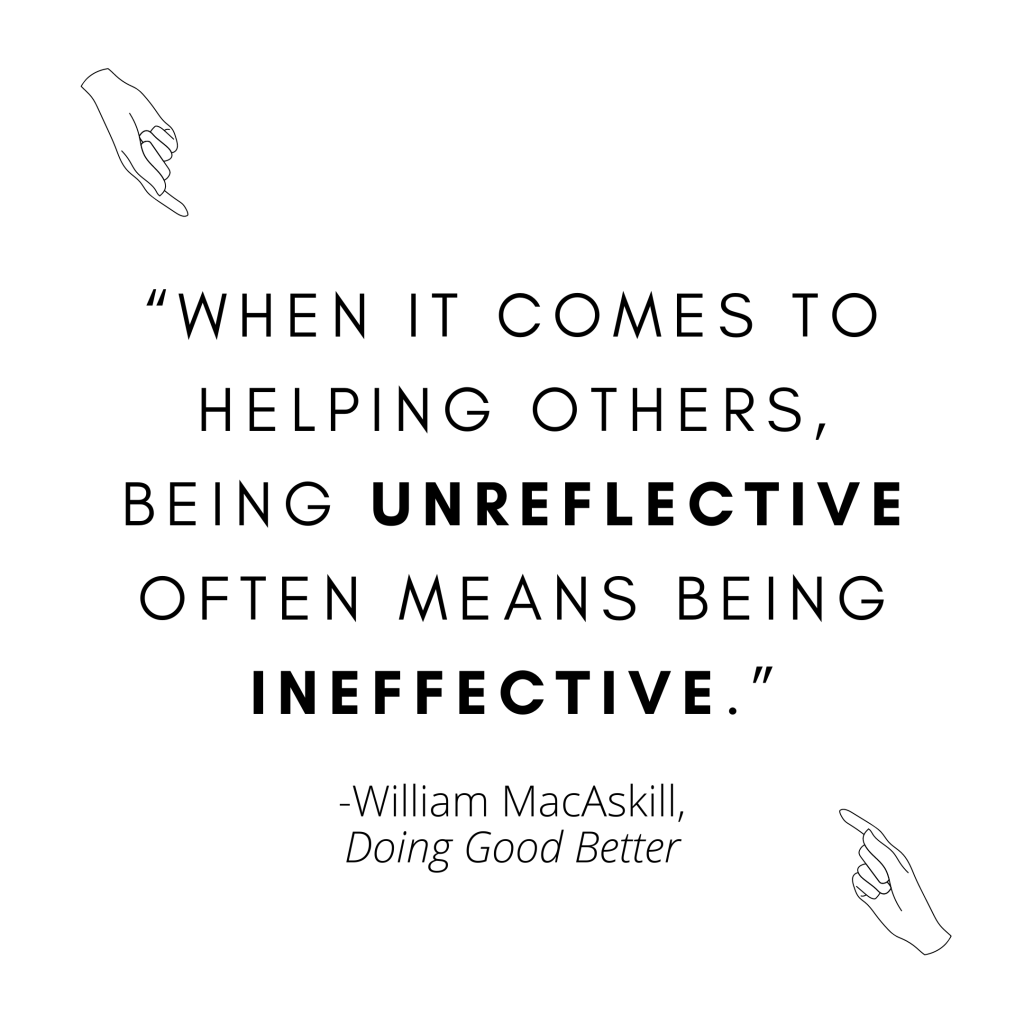“When it comes to helping others, being unreflective often means being ineffective.”
William MacAskill, “Doing Good Better”
Not all altruism is made equal.
This might seem obvious– if given the choice between doing more good than less, helping more people than fewer, we’d choose more, right?
In many other areas of life, decision-making is optimized around results: businesses use data analytics to quantify what strategies work with which customers, universities use extensive statistics (both quantitative and qualitative) to try to predict students’ future potential, and scientists run rigorous, year-long trials to discern which drug interventions work and which don’t. Whether we realize it or not, data- and evidence-based reasoning is how we operate effectively in a chaotic world.
Most of us want to do good: in our careers, lives, relationships, and ultimately, in the world. Many of us have some idea of what we’d like to change or how we’d like to help others. But why do we pursue the altruistic causes that we do, and what guides us in deciding how to make a difference in them? What does it mean to “do good” in the first place, and why does it matter how much good we’re doing? As long as we’re trying to do some amount of good, isn’t that good enough?
Effective altruism (EA) is a community and movement centered around a key question: how can I do the most good? It argues that if we’re committed to doing good, we should be committed to doing the most good. This doesn’t mean spending every waking second volunteering or donating all of our non-essential possessions to charity– it simply means that some causes are more effective to pursue than others, and some interventions are better at progressing these causes. If this mindset seems somewhat obvious or uninspired, I’d highly recommend this quick article that provides two powerful examples of how intuitive solutions often aren’t the most effective, and can even end up wasting resources and doing harm in the communities they’re intended to uplift. These stories changed the way I think about impact.
Each Thursday afternoon for the past seven weeks, I pulled myself away from internship and family obligations to join a Zoom call with 5 other students from my university to discuss how we can do the most good with our time, careers, resources, and lives. I participated in Brown’s first Effective Altruism (EA) virtual fellowship, which included weekly discussions led by a fellow student and based on foundational EA readings, questions, criticisms, and applications. Despite the chaos of the past few months and many other virtual commitments, close to 90 students across a range of majors and class years participated in the fellowship — I have never been so convinced of my generation’s excitement towards helping others and making real impact with their lives and careers.
Effective Altruism: What It Is & Why It Matters
“Given that most interventions seem to have low impact, we’re likely to focus on something that is not very impactful if we don’t pick carefully.”
Oxford Centre for Effective Altruism
Central to effective altruism is a framework that guides which cause areas should be prioritized, since we don’t have infinite resources (time, monetary, or otherwise) to devote to all causes. There are many people in the world who can (and are) helping, but there are also many people in need (and in many different ways), so who we decide to help and how is incredibly important.
Effective altruism focuses on three criteria for choosing a cause to be involved in:
- Importance: What is the scale of the problem? How many people are involved, and to what extent is their well-being affected?
- Neglectedness: How many other people, organizations, or institutions are already working to solve this problem?
- Tractability: Based on current research/evidence, how solvable is this problem? How much marginal effect will additional resources (funding, time, etc.) have on alleviating this issue?
EA explores the philosophical underpinnings of what “good” really means, our human biases and contradictions in making decisions to further this good, and how we can use data and evidence-based reasoning to support altruism. It focuses on the three main ways we can help:
- Donating money to effective charities: like different forms of altruism, charities aren’t created equal either, and the wrong donation can accomplish nothing. GiveWell has a list of top charities to donate to, based on how much good additional donations can do.
- Working in an impactful career: it’s estimated we have around 80,000 hours total in our career– that’s a lot of time! If you choose an area of high impact that’s best suited to your unique skills, you have the potential to make a crazy amount of difference in the world. The organization 80,000 hours is dedicated to helping people make the most impact through their careers (either directly or by earning to donate). Their career guide is a great place to start!
- Convincing other people to do the same: meeting new people and growing the EA community compounds your impact.. it’s also pretty fun! Check out the ~19,000 member EA Facebook Group to connect with others and continue learning.
A common and understandable criticism of EA is that using quantities and calculations to drive our altruistic efforts robs them of passion and true engagement. But EA is not about “submerging our passions in the service of rationality”. Rather, it’s an attitude and approach towards helping others that prioritizes the good we want to do in the world over whether a cause is interesting or compelling to us individually, or whether the people impacted by our actions live nearby (for more on owning your impact and listening before acting, check out “How not to be a white in shining armor” regarding the White-Savior Industrial Complex). If you’re still skeptical about how personal interests and passions can be compatible with the EA framework, I highly recommend “You have more than one goal and that’s fine”, written by Julia Wise, a member of the Community Health team at the Centre for Effective Altruism and an organizer of the Boston EA community.
“If we choose a cause that simply happens to be salient to us, we may overlook the most important problems of our time”
Centre for Effective Altruism
The conversations below inspired our first full week of Handful episodes!
Three Major Takeaways from the EA fellowship
- Intentionality & Contradiction
If we don’t actively choose to be intentional about the mental and moral frameworks by which we make decisions, we leave ourselves vulnerable to countless decision-making biases and contradictions that impair our ability to do the most good. A few weeks into the fellowship, we discussed the potential rights that non-human animals should have. A crash course philosophy video on non-human animals posed a question that revealed an inconsistency in my own behavior: why are we willing to potentially spend hundreds of dollars and countless hours pampering our pets when millions of other animals, including pigs and cows, live and are slaughtered in unspeakable conditions? What makes my dog Lucy more deserving of acceptable living standards and freedom from unnecessary pain than a piglet on a factory farm I’ve never visited? I wouldn’t accept such contradictions or lapses in judgment in other areas of my life, like school or work, so why in my efforts to make an impact?
- Categories & Intersectionality
Learning about plant-based and cell-cultured meat transformed my perspective on global problems. If you have 13 minutes, this Tedx talk Meat Without Animals: The Future Of Food by Good Food Institute co-founder Bruce Friedrich is incredible.
Chickens, the least-climate-inducing factory farm animal, have 40 times more climate impact per calorie of protein compared to legumes. They also require 9 calories of input to produce just 1 calorie of food. The ratio for pork is close to 15:1. And it takes about 25 calories to create just 1 calorie of beef.
Widespread factory farming is an environmental, medical and humanitarian issue that transcends categories of issues and influences everyone. We can create healthier, cheaper, safer, and more environmentally-sustainable meat with technology. When we think of food waste, we often think about food that goes rotten or is thrown away– but what about the food resources used to feed factory farm animals that never reach humans in the first place? Plant-based and cell-cultured meat can change that.
“Instead of trying to make people change how they think about their diet, let’s change the food– let’s innovate in meat”
Bruce Friedrich, co-founder and executive director at Good Food Institute
- Perspective & Ignorance
Not long after our first discussion on the treatment of non-human animals, my fellowship cohort got to talking about our own meat-consumption practices: in light of this new (at least to us) information, would we personally change our diets and consumption behaviors? One student proposed that eating vegetarian or vegan might not be nutritionally or financially viable for many families, which I believe is a widespread belief in the U.S. Another student responded that she had switched to vegetarian a few years prior and had never had to spend more money on groceries. A third student mentioned that she had never eaten meat (for religious reasons) and talked about the cultural inversion of meat being a luxury rather than a staple in other countries. Our backgrounds and initial experiences with topics can deeply inform (and misguide) our stances on issues for years into the future. This experience demonstrated to me just how important perspective is in shaping our view of what is and isn’t possible, especially with regards to altruism. For more on this topic, I highly recommend this quick, brilliant post on Idea inoculation & inferential distance.
Before the conversation was over, another student mentioned that she had been vegetarian for most of her life but never knew these reasons for being so. I too would consider myself a somewhat educated person, for my age: if I had never known the extent of this issue and my own power to do something about it, how many other problems were there that suffered progress from simple ignorance? It’s had me thinking ever since.
There are tons of great online resources available for learning more about EA and how you can get involved in the community, or simply apply the thought-process to your altruistic endeavors. Here’s a few of my favorite random conversation topics from our fellowship discussions:
5 actions you can take today to start making an (effective!) impact:
- Browse the EA “Take Action” homepage to get a better idea of what’s out there
- Listen to an episode of the 80,000 hours podcast (“In-depth conversations about the world’s most pressing problems and how you can use your career to solve them”)
- Check out the 80,000 hours career guide and their list of high impact careers to evaluate how your current professional plans stack up against alternatives
- Tell a friend about Effective Altruism or share this article with them
- Pick up a copy of “Doing Good Better” by William MacAskill (co-founder of the Centre for Effective Altruism as well as Researcher at the Oxford Global Priorities Institute, Professor of Philosophy at Oxford, co-founder/President of 80,000 hours, and co-founder/VP of Giving What We Can)
Effective Altruism is certainly not a flawless or comprehensive approach to altruism, and like any human-designed perspective, it has its limitations. Certain approaches (particularly related to cause-prioritization, donation strategies, and non-human animals) can be controversial, especially without fully understanding the key assumptions that EA makes. If there are topics of concern you’d like to discuss further, or ways I could have introduced the subject with greater clarity or sensitivity, please send me an email (erika_bussmann@brown.edu) and I’d love to continue the conversation!

- Activism, Meet Impact: Erika on GameStop, Hacktivism and Empathy - February 8, 2021
- Innovative is not Progressive: What Technology Means to Activists - January 5, 2021
- Hacktivism: Resistance from Digital Gabon - December 8, 2020
